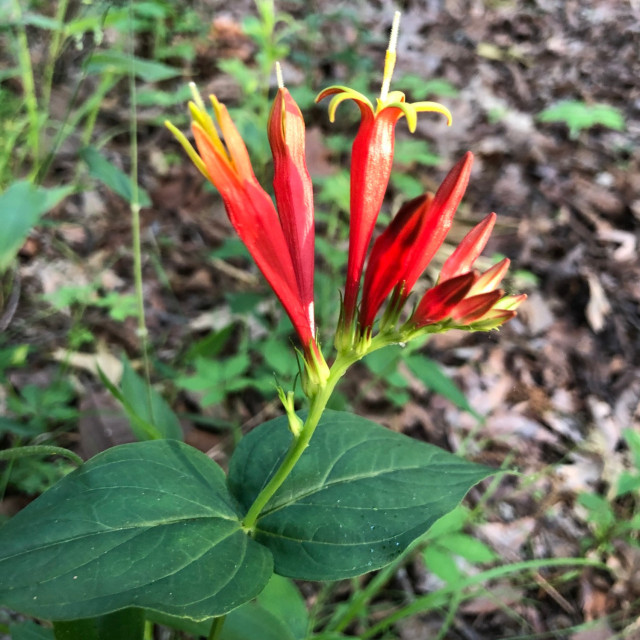COMMON NAME
Indian Pink
SCIENTIFIC NAME
Spigelia marilandica
ALSO KNOWN AS
woodland pinkroot
Plant family
Logania (Loganiaceae)
Plant group
Wildflowers and Herbs
Indian pink is an herbaceous perennial native to the midwestern and southeastern United States.
27 reports
11+
OBSERVERS
27+
OBSERVATIONS
Identification hints
Indian pink has prominent red and yellow tubular flowers that are pollinated by hummingbirds. The dark green leaves are opposite, simple, and attach directly to the main stem.
Did you know?
The red flowers of indian pink contain nectar that is an important food source for hummingbirds. Although generally viewed as poisonous, Indigenous peoples of North America knew how to prepare the roots of the plant in a tea that would treat intestinal parasites due to the presence of the alkaloid spigeline.
DISTRIBUTION IN TH U.S.
Alabama
,
Arkansas
,
Florida
,
Georgia
,
Illinois
,
Indiana
,
Kentucky
,
Louisiana
,
Maryland
,
Missouri
,
Mississippi
,
North Carolina
,
Oklahoma
,
South Carolina
,
Tennessee
,
Texas
,
Virginia
HABITAT
Indian pink is found in shaded woods, open woodlands, woodlands’ edge, forest openings and in moist, sandy, fertile loam and acidic soils.
ATTRIBUTES
Leaves
The glossy, emerald green leaves of indian pink are oppositely arranged, and have smooth edges. Leaves are lance shaped and occur in 4 to 7 pairs along a wiry stem. Leaves do not have stalks (petioles) and their veins are prominent.
Flowers
Flowers of indian pink are borne at the end of each stalk. Flowers are arranged in a one-sided spike of deep-red to scarlet tubular/trumpet-shaped flowers, up to 2 in (5 cm) long, each ending in five yellow lobes. The flowers have a dramatic color contrast, and are red on the outside and yellow on the inside. The five pointed petals reflex back to show their yellow lining, which resembles a yellow star. They have five stamens, and the anthers are erect and poking out of the flower.
Fruits
The fruits of indian pink are a dry capsule with two chambers that contain irregularly angled black seeds. The capsule disburses seeds by popping open explosively at maturity.
Bloom Time
Indian pink typically blooms for about a month and generally blooms between March and May depending on the location.
See Menu
Budburst is a project of the
Chicago Botanic Garden
One of the treasures of the
Forest Preserves of Cook County
Creative Commons
BY-NC-SA 4.0
- 2021 Chicago Botanic Garden. All Rights Reserved.
- Terms of Use
- Privacy Policy
- Data Sharing and Citation Policies
- 2021 Chicago Botanic Garden. All Rights Reserved.



